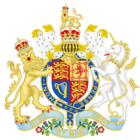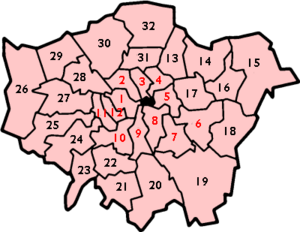London Government Act 1963 facts for kids

|
|
| Long title | An Act to make provision with respect to local government and the functions of local authorities in the metropolitan area; to assimilate certain provisions of the Local Government Act 1933 to provisions for corresponding purposes contained in the London Government Act 1939; to make an adjustment of the metropolitan police district; and for connected purposes. |
|---|---|
| Citation | 1963 c.33 |
| Territorial extent | Greater London |
| Dates | |
| Royal assent | 31 July 1963 |
| Commencement | 1 April 1965 |
|
Status: Current legislation
|
|
| Text of statute as originally enacted | |
| Text of the London Government Act 1963 as in force today (including any amendments) within the United Kingdom, from legislation.gov.uk | |
The London Government Act 1963 was an important law passed by the Parliament of the United Kingdom. This Act completely changed how London was governed. It created a new, larger area called Greater London and set up a new system of local government within it.
Before this Act, London had many smaller local areas. The 1963 Act brought these together, creating fewer, but much larger, local councils. These new councils were responsible for bigger areas and more people. The Act also created a main council for all of Greater London, which had a more strategic role. The way jobs were shared between the main council and the local councils also changed. The Act divided the new local areas, called boroughs, into two groups: Inner London and outer London. The City of London kept its old system and was not changed much by this law.
Over time, parts of the Act have been updated. For example, the main council for Greater London, called the Greater London Council (GLC), was removed in 1986. Later, the Greater London Authority was created in 2000 to take its place. As of 2016, the local London boroughs are still mostly the same as those created in 1965. They now have more power over services like managing waste and education.
Contents
What the Act Did: Key Changes to London's Government
The London Government Act 1963 set up a two-level system for local government. Power was shared between the new Greater London Council (GLC), 32 new London borough councils, and the existing City of London. These changes officially started on 1 April 1965. The new councils were actually elected in 1964 as "shadow authorities" to prepare for the change.
Section 1 of the Act created 32 London boroughs. Each borough was to be run by an elected council. Twelve of these boroughs were in the old County of London area and were called Inner London boroughs. The other twenty boroughs were called Outer London boroughs. The Act did not give names to these new boroughs at first.
Section 2 stated that the area made up of the London boroughs, the City of London, and the Temples would become an administrative area known as Greater London. An elected Greater London Council was put in charge of this new, larger area.
Section 3 got rid of the old administrative counties of Middlesex and London. It also took parts of Kent, Essex, Surrey, and Hertfordshire, along with the whole City of London, to form the new Greater London area. This meant that many old local areas, like the twenty-eight metropolitan boroughs and other districts, stopped existing. No part of Greater London was to be part of any other administrative county. A few areas from Middlesex that were not included in Greater London were moved to other counties. For example, Potters Bar went to Hertfordshire, and Staines and Sunbury-on-Thames went to Surrey.
The Act also created the Inner London Education Authority. This authority managed schools and colleges in the 12 Inner London boroughs. The other 20 Outer London boroughs became their own local education authorities. The Act also removed the old London Traffic Area and its advisory committee. The GLC then gained powers to manage road traffic. The Metropolitan Police District was also changed to cover all of Greater London, though it still included some areas in nearby counties.
How the New Boroughs Were Formed
The Act listed how the new London boroughs would be put together from the many smaller areas that existed before. For example, some new boroughs were formed by combining several old metropolitan boroughs, while others combined municipal boroughs or urban districts.
Here are a few examples of how some boroughs were created:
- Borough 1 combined the old metropolitan boroughs of Westminster, Paddington, and St Marylebone.
- Borough 5 brought together Bethnal Green, Poplar, and Stepney.
- Borough 17 included the county boroughs of East Ham and West Ham, plus parts of Barking and Woolwich.
The Act created 12 Inner London boroughs and 20 Outer London boroughs.
Naming the New Boroughs
When the Act was first passed, it didn't give names to the new boroughs. The Minister in charge, Keith Joseph, asked local councils for ideas. He suggested single-word names if possible, and that the name should reflect the main centre of the new borough. Double-barrelled names were generally not allowed.
Many councils found it hard to agree on names. For example, Lewisham and Deptford couldn't decide between "Lewisham," "Deptford," or "Ravensbourne." Some areas suggested names like "Northgate" or "New River."
However, nine names were quickly agreed upon and suggested in September 1963:
- Westminster (Borough 1)
- Camden (Borough 2)
- Tower Hamlets (Borough 5)
- Redbridge (Borough 14)
- Newham (Borough 17)
- Croydon (Borough 20)
- Kingston upon Thames (Borough 23)
- Ealing (Borough 27)
- Haringey (Borough 31)
In October 1963, the Minister suggested names for six more boroughs that couldn't decide:
- Bexley (Borough 18)
- Bromley (Borough 19)
- Sutton (Borough 21)
- Richmond upon Thames (Borough 24)
- Hounslow (Borough 25)
- Hillingdon (Borough 26) (originally suggested as Uxbridge)
By January 1964, twelve more names were proposed:
- Greenwich (Borough 6)
- Islington (Borough 3)
- Hackney (Borough 4)
- Lewisham (Borough 7)
- Southwark (Borough 8)
- Wandsworth (Borough 10)
- Kensington and Chelsea (Borough 12)
- Waltham Forest (Borough 13)
- Havering (Borough 15)
- Barking (Borough 16)
- Merton (Borough 22) (originally suggested as Morden)
- Barnet (Borough 30)
- Enfield (Borough 32)
One special case was the borough formed from Chelsea and Kensington. Their councillors wanted to keep both names. So, the Minister made an exception, and it became the Royal Borough of Kensington and Chelsea.
How Jobs Were Divided Among Councils
The Act clearly set out which services and responsibilities each new authority would handle:
| Greater London Council (GLC) | Shared Responsibilities | London Boroughs |
|---|---|---|
|
|
|
Why the Act Was Created: The Herbert Report
The idea for changing London's government came from a special group called a royal commission. This group was set up in 1957, led by Sir Edwin Herbert. Their job was to study how local government in Greater London could be improved. The commission released its report in October 1960. It suggested creating a Greater London area with 52 new Greater London Boroughs.
The Greater London area that was eventually set up by the 1963 Act was very similar to what the Herbert Report suggested. However, some areas were left out, like Banstead and Esher in Surrey, and Chigwell in Essex.
The Act's Journey Through Parliament
The government thought the new boroughs should be fewer and larger. So, in late 1961, they published their plan for 34 London boroughs. This plan changed some of the earlier ideas from the Herbert Report. For example, it suggested different combinations for areas like Camden, Westminster, and Islington.
During this process, some areas asked to be left out of Greater London. In May 1961, five urban districts (Cheshunt, Chigwell, Esher, Staines, and Sunbury) were removed from the plan. Other requests, like those from Romford and Barnet, were turned down.
In August 1962, the number of proposed boroughs was reduced from 33 to 32. More detailed changes were made. For example, Shoreditch was to join Hackney, and Wanstead and Woodford were added to Ilford to form 'Redbridge'. The final, slightly changed plan was debated in Parliament from November 1962 to April 1963. This led to the 32 boroughs we know today.
Support for the Act
Those who supported the Bill believed it was necessary because Greater London had grown into a single, large city. They argued that the old system, which was based on boundaries from 1889, no longer made sense.
Earl Jellicoe, a government minister, said that London was "a living organism with its heart, its limbs and its lungs." He believed that the government for such a large city needed strong powers across the whole area to be effective. Sir Keith Joseph, another minister, also argued that it was "ludicrous" not to acknowledge that people lived in "the greatest capital city in the world" and that its government needed to be reorganised for the next half-century.
Opposition to the Act
However, many people, especially those in the Opposition parties, were against the Bill. They saw it as a political move. They argued that the London County Council (LCC), which was the main council for London at the time, had been very successful and popular.
Viscount Alexander of Hillsborough, a Labour leader, said that the government was "going through with this execution of the London County Council because they have been so successful." John Parker, a Labour MP, also believed it was a "party political Bill" and that if the LCC could be destroyed for political reasons, so could the City of London's council.
Some Conservative MPs also sympathised with local people who did not want to join London. For example, many people from Croydon and nearby towns signed petitions against joining. Charles Doughty, an MP for East Surrey, said that a "shotgun marriage" between Coulsdon, Purley, and Croydon would "never be successful" because their local ties were to the south, not to London. Despite these objections, the Bill passed, and the new boundaries have been in place since 1 April 1965.
Later Changes to the Act
Over the years, other laws have changed parts of the London Government Act 1963.
Local Government Act 1972
This Act allowed councils to change their names. For example, the London Borough of Hammersmith added "and Fulham" to its name, and the London Borough of Barking became the London Borough of Barking and Dagenham.
Local Government Act 1985
This Act got rid of the Greater London Council (GLC). Its responsibilities were then given to the London borough councils, to joint groups of councils, or to the central government. The Inner London Education Authority continued to exist as a separate, elected body for a while longer.
Education Reform Act 1988
This Act abolished the Inner London Education Authority. After this, the Inner London boroughs became responsible for education in their own areas, just like the Outer London boroughs.
Greater London Authority Act 1999
This Act created the Greater London Authority (GLA). The GLA took over from where the Greater London Council left off, becoming the new main authority for Greater London.


